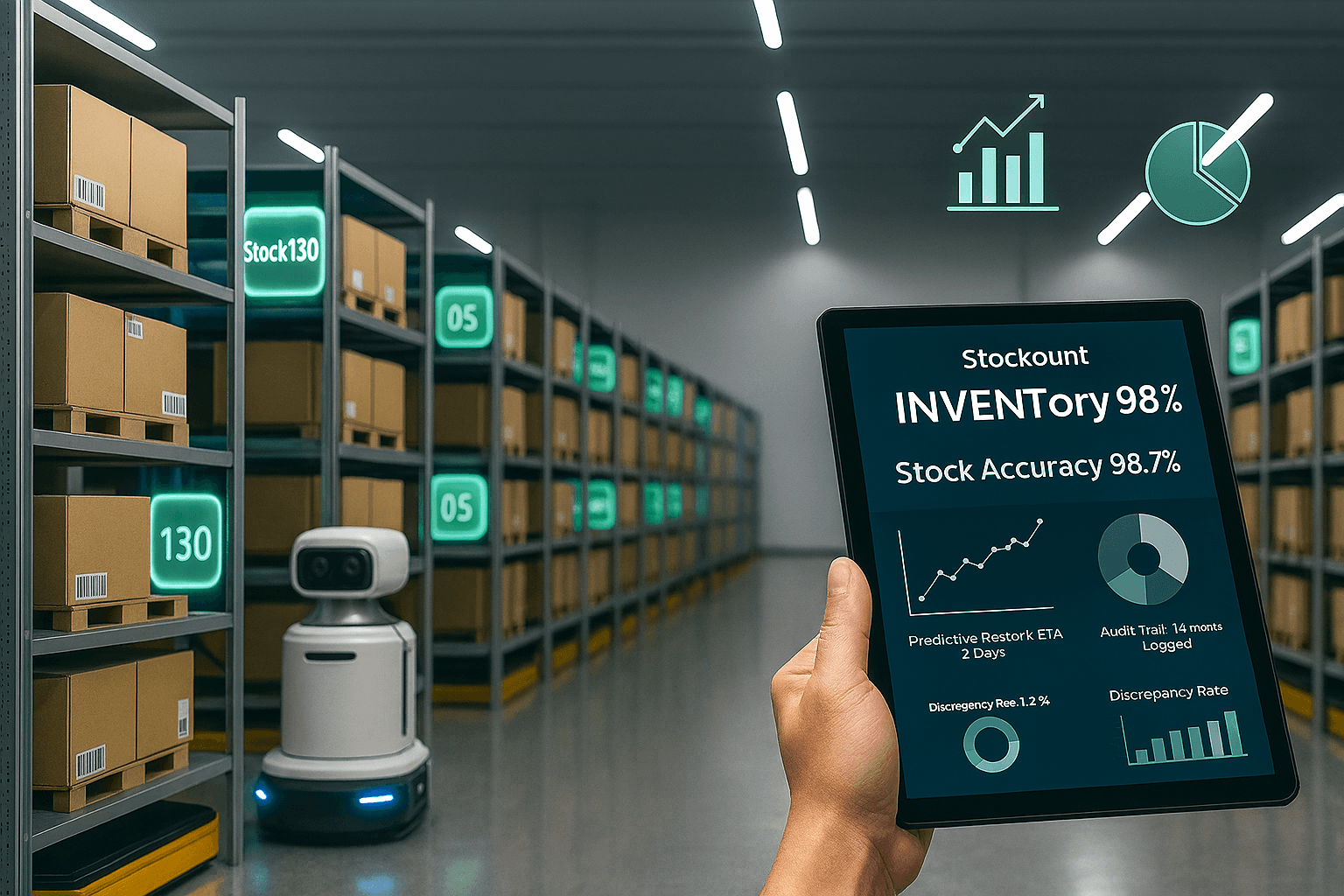

October 27, 2025 | By Stockount

For the majority of small and medium-sized businesses (SMBs)—from local retailers and growing e-commerce stores to regional distributors and small manufacturers,inventory auditing is a necessary evil. It’s often defined by tedious manual counts, frustrating data errors, and the sinking feeling that your reported stock doesn't match reality.
But a fundamental shift is underway.
The future of inventory audit management is no longer a slow, manual task; it is a continuous, intelligent, and real-time operation driven by AI, Automation, and Predictive Analytics.
If your business still relies on paper logs, spreadsheets, or outdated software, you’re not just wasting labor, you’re hindering growth and sacrificing profit. Here’s how next-generation inventory platforms are redefining accuracy and profitability across industries.
Traditional inventory methods are a drag on efficiency and profitability, leading to chronic issues that stunt business growth.
Manual counts are prone to human error, leading to stock variance between physical count and system records. This often masks true shrinkage (damage, theft, or misplacement), directly impacting your cost of goods sold (COGS).
Periodic (monthly or quarterly) audits only provide historical data. By the time discrepancies are identified, you’ve already missed sales opportunities or incurred high costs from emergency ordering.
Diverting valuable employees to perform days of physical counting is inefficient. Those hours could be better spent on sales, production, or customer service.
The solution isn't to count faster it's to count smarter, and ultimately, count less.
Automation transforms inventory from a periodic chore into a continuous, hands-off operation,dramatically increasing accuracy and cutting audit times.
Modern systems replace clipboards and spreadsheets with mobile-integrated technology:
Mobile-First Audits: Staff can conduct fast, accurate mobile audits using barcode or QR code scanning. Data instantly validates against the master inventory, no manual keying errors.
Perpetual Inventory & Cycle Counting: Instead of disruptive wall-to-wall counts, automation enables continuous cycle counts. The system schedules quick counts for high-value items or high-risk zones, ensuring continuous real-time visibility.
Seamless Integration: The system connects with POS, e-commerce (Shopify, Amazon), and accounting platforms (QuickBooks). Every sale, return, and receipt automatically updates inventory records.
How Stockount Solves This:
Stockount offers mobile-first audit tools with photo validation and cross-checking, ensuring 99.9% inventory accuracy while cutting manual reconciliation time significantly.
If automation manages how you track, AI manages what the data means. It brings forensic precision and predictive oversight that human teams can’t achieve at scale.
AI algorithms continuously monitor data flow, instantly flagging discrepancies linked to waste, theft, or errors.
The Variance Detective: AI compares expected vs. recorded stock movement. Spikes or recurring mismatches in certain SKUs or warehouse zones are flagged for review, pinpointing shrinkage sources.
Dead Stock and Expiry Management: AI tracks sales velocity, shelf life, and holding costs, alerting you to expiries and recommending markdowns or liquidation for slow-moving SKUs.
AI-powered dashboards translate complex data into clean, actionable insights:
Predictive analytics turns inventory management into a competitive advantage. It uses historical data, seasonality, and market trends to predict what’s next.
This is where efficiency meets profitability.
Automated Reordering: The system predicts demand per SKU and automatically generates purchase orders when stock nears optimal reorder points—preventing stockouts and excess inventory.
Multi-Location Stock Balancing: For multi-store or warehouse operations, predictive models suggest transfers to balance stock, avoiding surplus in one location and shortage in another.
The result? A lean, agile, data-driven operation that scales efficiently, reduces bottlenecks, and ensures you always have the right stock at the right time.
AI-enabled auditing isn’t just a trend, it’s a business necessity. Over 75% of SMBs are adopting AI for operational efficiency. Early adopters enjoy stronger compliance, clearer financial visibility, and a sharper competitive edge.
Small steps lead to big wins, start with audit automation, move to predictive forecasting, and integrate AI-driven analytics. It’s time to ditch clipboards and spreadsheets.
Embrace Stockount’s AI-powered audit automation to:
Stop Shrinkage: Detect and prevent over-pouring or theft instantly.
Cut Costs: Eliminate rush orders and free up capital from dead stock.
Ensure Accuracy: Maintain real-time, 99.9% accuracy across all locations.
The future of inventory auditing isn’t about counting more, it’s about eliminating the need to count at all.
Automation eliminates human error, saves time, and ensures consistent accuracy across locations. It’s the fastest route to reliable, real-time stock control.
AI continuously monitors stock data, detecting discrepancies early. This ensures transparent, verifiable, and compliance-ready reports.
Yes. Predictive analytics uses historical and market data to forecast needs, enabling smarter reorder decisions that improve cash flow and reduce waste.
With cloud-based tools like Stockount, AI-driven audits are cost-effective and scalable. Businesses pay only for what they use—no complex setup required.
Retail, e-commerce, manufacturing, and distribution—all gain from automation and analytics that improve accuracy, minimize losses, and enhance efficiency.